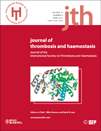
JOURNAL OF THROMBOSIS AND HAEMOSTASIS
Scope & Guideline
Transforming Patient Care Through Cutting-Edge Research
Introduction
Aims and Scopes
- Thrombosis and Hemostasis Mechanisms:
Investigates the fundamental biological processes underlying thrombosis and hemostasis, including coagulation pathways, platelet function, and the role of the endothelium. - Bleeding Disorders:
Focuses on the diagnosis, treatment, and management of inherited and acquired bleeding disorders, such as hemophilia, von Willebrand disease, and others. - Anticoagulation and Thrombotic Risk Management:
Explores the efficacy and safety of anticoagulant therapies, risk assessment strategies, and guidelines for managing patients at risk of thromboembolic events. - Clinical Trials and Innovations:
Reports on novel therapeutic approaches, including gene therapies, monoclonal antibodies, and emerging anticoagulants, aimed at improving patient outcomes. - Translational Research:
Emphasizes studies that translate laboratory findings into clinical practice, providing insights that can directly impact patient care in thrombosis and hemostasis. - Guidelines and Best Practices:
Provides updates and consensus guidelines from leading experts and committees on the management of various thrombotic and bleeding disorders.
Trending and Emerging
- Gene Therapy for Hemophilia:
Emerging studies on gene therapy approaches for hemophilia treatment are on the rise, showcasing innovative strategies to address genetic deficiencies in coagulation factors. - COVID-19 Related Thrombosis Research:
Significant attention is being given to the thrombotic complications associated with COVID-19, including mechanisms, management, and long-term outcomes. - Personalized Medicine in Thrombosis Management:
Research focusing on individualized treatment strategies, including the use of genetic and phenotypic markers to guide anticoagulation therapy, is gaining traction. - Impact of Inflammation on Coagulation:
Studies exploring the relationship between inflammation and coagulation pathways are becoming increasingly relevant, particularly in chronic diseases and infection contexts. - Advanced Imaging and Biomarker Studies:
There is a growing interest in the use of advanced imaging techniques and biomarker identification to improve the diagnosis and management of thrombotic disorders.
Declining or Waning
- Traditional Diagnostic Assays:
There is a noticeable decrease in studies focused solely on traditional diagnostic assays for coagulation disorders, as newer, more advanced methodologies gain traction. - Basic Science Without Clinical Relevance:
Research that does not directly translate into clinical applications or patient outcomes appears to be receiving less attention, as the journal emphasizes studies with clear implications for patient care. - Pharmacological Interventions with Limited Evidence:
Topics that discuss pharmacological interventions lacking robust clinical trial data or clear efficacy are becoming less common, as the journal's readership seeks evidence-based findings. - Historical Perspectives:
Papers centered on historical analyses of thrombosis and hemostasis are decreasing, possibly as the focus shifts towards innovative and forward-looking research.
Similar Journals

THROMBOSIS RESEARCH
Elevating Hematology Through Rigorous ResearchTHROMBOSIS RESEARCH is a leading peer-reviewed journal in the field of hematology, published by PERGAMON-ELSEVIER SCIENCE LTD. With an impressive impact factor and ranked within the top 10 of 137 in its category according to Scopus, this journal provides a critical platform for the dissemination of innovative research related to thrombosis and hemostasis. Established in 1972, THROMBOSIS RESEARCH has been at the forefront of scholarly communication, addressing key issues, findings, and advancements over more than five decades. Recognized for its high-quality content, the journal is categorized in the Q1 quartile for 2023, reflecting its influence and relevance within the scientific community. Researchers, medical professionals, and students engaged in the study of blood disorders will find valuable insights and the latest discoveries within its pages. Although currently not an open-access publication, THROMBOSIS RESEARCH remains accessible to a wide audience through institutional subscriptions, ensuring that vital research continues to inform and enhance clinical practices around the globe.
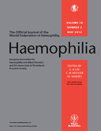
HAEMOPHILIA
Innovating the future of hemophilia treatment.HAEMOPHILIA is a leading peer-reviewed journal published by Wiley, dedicated to advancing research and clinical practices in the fields of hematology and genetics. With an impressive Impact Factor and recognition within the Q1 category for Genetics (clinical), Hematology, and Medicine (miscellaneous), this journal presents a unique platform for the dissemination of high-quality research from 1995 to the present. Researchers in these dynamic fields will find invaluable insights through original articles, systematic reviews, and clinical trials, all aimed at improving therapeutic strategies and patient outcomes. Although it operates on a subscription basis, HAEMOPHILIA's commitment to excellence is reflected in its Scopus rankings, where it stands in the 74th percentile for hematology and the 71st percentile for clinical genetics. As an essential resource for academics, healthcare professionals, and students, HAEMOPHILIA plays a pivotal role in fostering innovation and collaboration within the global medical community.
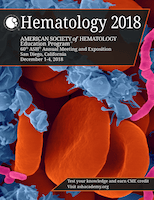
Hematology-American Society of Hematology Education Program
Navigating the Future of Hematology TogetherHematology-American Society of Hematology Education Program is a premier peer-reviewed journal dedicated to advancing the field of hematology through comprehensive educational content. Published by the American Society of Hematology, this journal plays a crucial role in disseminating knowledge to researchers, clinicians, and students in hematology and related disciplines. With an impressive Q1 status in the field, it ranks among the top journals at the forefront of hematological research, as evidenced by its 60th percentile ranking in Scopus' Medicine - Hematology category. Although it does not offer open access, the journal provides invaluable insights and educational resources from leading experts, focusing on the latest advancements, treatment protocols, and evolving understanding of blood disorders. Covering a wide range of topics, from basic research to clinical applications, this journal is essential for anyone seeking to deepen their expertise and stay informed on the latest developments in hematology. For further engagement, readers can access insightful articles published since 2001, ensuring a rich repository of knowledge for ongoing research and clinical excellence.

Blood Advances
Shaping the Landscape of Hematology ResearchBlood Advances is a premier, peer-reviewed journal published by Elsevier, dedicated to the field of hematology. With an impressive impact factor and classified within the Q1 category of hematology for 2023, it ranks as the 16th out of 137 journals in the Scopus Medicine Hematology category, placing it in the top 88th percentile globally. This influential journal, which has been disseminating invaluable research since its inception in 2017, focuses on advancing knowledge and innovation in blood science, including clinical and laboratory aspects of hematology. Although it offers limited open access features, its comprehensive scope encompasses various topics relevant to both researchers and practitioners. Located in the United States and managed from Amsterdam, Blood Advances provides a vital platform for the dissemination of groundbreaking research, making significant contributions to the understanding and treatment of blood disorders. Researchers, professionals, and students alike will find this journal an essential resource for keeping abreast of the latest developments and advancements in hematology.

Research and Practice in Thrombosis and Haemostasis
Innovating hematology through open-access insights.Research and Practice in Thrombosis and Haemostasis, published by Elsevier, is a prominent open-access journal dedicated to advancing the field of hematology through high-quality research and clinical practice. Since its inception in 2017, this journal has established itself as a vital resource for researchers, healthcare professionals, and students interested in thrombosis and hemorrhage management, showcasing original research, reviews, and clinical studies. The journal’s commitment to accessible knowledge is reflected in its open-access model, allowing researchers worldwide to share their findings without financial barriers. With an impressive 2023 Scopus rank of #42 out of 137 in the hematology category and a respectable Q2 classification, it provides an authoritative platform for innovative ideas and cutting-edge developments in the field. As the journal continues to grow in stature, it aims to foster collaboration and knowledge exchange amongst professionals dedicated to improving patient outcomes in thrombosis and hemostasis.

Annals of Vascular Diseases
Advancing Vascular Research for a Healthier TomorrowAnnals of Vascular Diseases is a leading international journal dedicated to the comprehensive exploration of vascular pathology, aimed at advancing knowledge in the field through innovative research and insightful reviews. Published by the ANNALS VASCULAR DISEASES EDITORIAL OFFICE and available in both print (ISSN: 1881-641X) and electronic format (E-ISSN: 1881-6428), this journal has embraced Open Access since 2017, facilitating wider dissemination and accessibility of vital research findings. With its focus on clinical and experimental studies relating to vascular diseases, the journal serves as a crucial platform for researchers, medical professionals, and students who seek to stay at the forefront of clinical advancements. By fostering collaboration and sharing knowledge, Annals of Vascular Diseases plays a significant role in shaping the future of vascular research and treatment strategies worldwide.
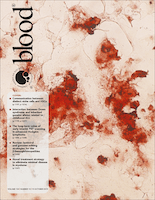
BLOOD
Advancing the Science of Hematology.BLOOD, published by the American Society of Hematology, is a premier peer-reviewed journal in the fields of Biochemistry, Cell Biology, Hematology, and Immunology. With an impressive impact factor and ranking in the top quartiles (Q1) across multiple disciplines, BLOOD is essential reading for researchers and professionals seeking to stay updated on the latest advancements in hematology and related fields. The journal has been a cornerstone of hematological research since its inception in 1946, providing a platform for rigorous scientific inquiry and discourse. Its commitment to publishing high-quality original research, comprehensive reviews, and insightful editorials makes it a vital resource for students, practitioners, and scientists alike. By offering exceptional access to influential publications, BLOOD continues to shape the future of hematology and enhance understanding of blood-related disorders, marking its vital role in advancing both basic and clinical research.

THROMBOSIS AND HAEMOSTASIS
Elevating Knowledge in Thrombosis ResearchTHROMBOSIS AND HAEMOSTASIS is a prestigious journal published by GEORG THIEME VERLAG KG, dedicated to advanced research in the field of hematology. With an esteemed Impact Factor and recognized as Q1 in its category for 2023, the journal is regarded for its pivotal role in disseminating significant findings that contribute to our understanding of thrombosis and hemostasis. Since its inception in 1976, this journal has continuously published cutting-edge studies and reviews, making it a vital resource for researchers, healthcare professionals, and students alike. The journal’s commitment to high-quality research is reflected in its impressive Scopus Ranking of #18 out of 137 in Medicine - Hematology, placing it in the 87th percentile among its peers. Although not currently open access, THROMBOSIS AND HAEMOSTASIS remains an authoritative source for exploring novel therapeutic strategies and the latest scientific advancements in the field. Based in Stuttgart, Germany, this journal serves as a critical platform for sharing knowledge and fostering collaboration within the global hematology community.
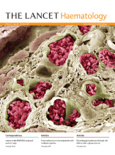
Lancet Haematology
Bridging clinical practice and pioneering research.Lancet Haematology, published by Elsevier Science Ltd in the United Kingdom, is a premier peer-reviewed journal dedicated to advancing the field of hematology. With an impressive impact factor and listed in the Q1 category in hematology for 2023, this journal ranks #4 out of 137 in the Scopus database, boasting a 97th percentile indicating its influential role in disseminating high-quality research. Since its establishment in 2014, Lancet Haematology has provided a vital platform for researchers and clinicians to share groundbreaking studies, innovative treatment approaches, and novel therapeutic discoveries relevant to various hematological disorders. The journal does not operate under an open access model, but it offers multiple access options to facilitate engagement with its content. By bridging clinical practice and cutting-edge research, Lancet Haematology aims to foster the advancement of knowledge and improve patient outcomes in hematology, making it an essential read for professionals, researchers, and students alike.

Journal of Hematology
Elevating Hematology Through Collaborative ResearchThe Journal of Hematology, published by ELMER PRESS INC, serves as a pivotal platform for disseminating cutting-edge research in the field of hematology. With an ISSN of 1927-1212 and an E-ISSN of 1927-1220, this journal is committed to advancing scientific knowledge and clinical practice through high-quality peer-reviewed articles encompassing all aspects of blood disorders, from basic science to health policy implications. While the journal currently operates under a traditional access model, it nonetheless prioritizes the rapid publication of significant findings, ensuring that researchers, clinicians, and students have timely access to the latest advancements in hematological research. Positioned to bridge gaps in knowledge and foster collaboration among scholars worldwide, the Journal of Hematology is an essential resource for anyone invested in this vital area of medicine.